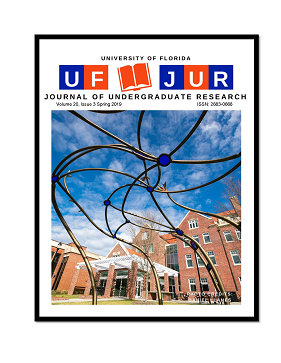A Study of Organic Food Labeling In the United States Compared to Denmark
DOI:
https://doi.org/10.32473/ufjur.v20i3.106163Keywords:
organic food labelingAbstract
Organic farming practices produce foods that avoid manufactured fertilizers, pesticides, growth regulators (GMOs), and livestock additives. The definition of what is considered organic in the United States is that 95 percent of the ingredient list must be free of synthetic additives and must not be processed using industrial solvents. The goal of the study was to compare organic labeling and certification between the United States and Denmark. The hypothesis is that labeling and regulation will be similar because the food economy is built on a global scale. Researching organic labeling was required in both the United States and Denmark. A study of one food item from each section of the US food pyramid was completed. Then, labeling data was collected in both Danish and American grocery stores. The work required visiting three grocery stores in both countries. The results were organic labeling requirements are different in the US and Denmark. Denmark has a much more stringent level of organic certification, store labels of studied products confirm these differences. The study demonstrated that organic labeling, is very complicated in both the US and Denmark, and there is not a common standard of organic labeling and certification between these two countries.
References
Jankowska, M. (2017). U.S. food labelling regulations vs. freedom of speech- Creation of "qualified health claims". European Food and Feed Law Review,12, 142-150. Retrieved March 15, 2018, from http://heinonline.org/HOL/LandingPage?handle=hein.journals/effl2017&div=26&id=&page=
Greene, C. (2007). An Overview of Organic Agriculture in the United States. In Organic Food(pp. 17-18). New York, NY: Springer. Retrieved February 1, 2018, from https://link.springer.com/chapter/10.1007/978-0-387-39582-1_2#citeas.
S. (2018, January). Worldwide Sales of Organic Food from 1999 to 2016(in billions of dollars). Retrieved February 13, 2018, from https://www.statista.com/statistics/273090/worldwide-sales-of-organic- foods-since-1999/
Sønderskov, K. M., & Daugbjerg, C. (2011). The state and consumer confidence in eco-labeling: Organic labeling in Denmark, Sweden, The United Kingdom and The United States. Agriculture and Human Values,28(4), 507-517. Retrieved March 13, 2018, from https://link.springer.com/article/10.1007/s10460-010-9295-5#citeas.
U. (2015, November). Guidance for Industry: Voluntary Labeling Indicating Whether Foods Have or Have Not Been Derived from Genetically Engineered Plants. Retrieved March 10, 2018, from Nutrition/ucm059098.htm#references
M. (2012). Danish Organic Logo. Retrieved February 10, 2018, from http://en.mfvm.dk/focus-on/organic-denmark/danish-organic-logo/
M. (2018, January). Better Animal Welfare. Retrieved January 28, 2018, from https://www.foedevarestyrelsen.dk/kampagner/Bedre-dyrevelfaerd/Sider/forside.aspx
M. (2012, January). Organic Production and Consumption. Retrieved March 8, 2018, from http://en.mfvm.dk/focus-on/organic-denmark/organic-production-and-consumption/
Greene, C. (2016, September 22). Organic Production Documentation. Retrieved February 8, 2018, from https://www.ers.usda.gov/data-products/organic-production/documentation/
Downloads
Published
Issue
Section
License
Some journals stipulate that submitted articles cannot be under consideration for publication or published in another journal. The student-author and mentor have the option of determining which journal the paper will be submitted to first. UF JUR accepts papers that have been published in other journals or might be published in the future. It is the responsibility of the student-author and mentor to determine whether another journal will accept a paper that has been published in UF JUR.

